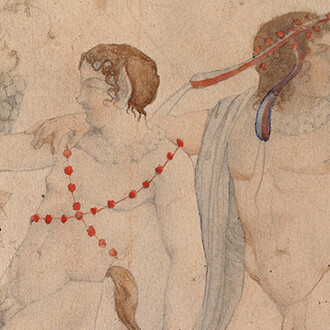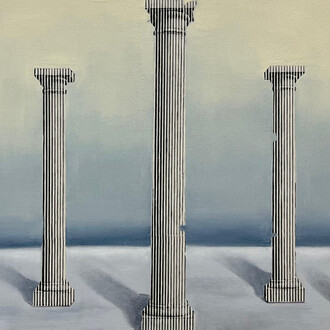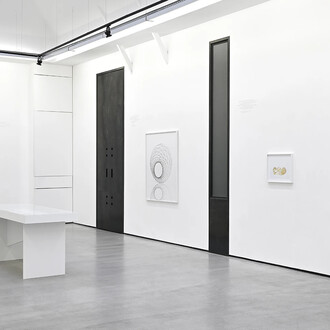Perrotin is pleased to present Ribbon sharp, Chiffon Thomas’s first solo exhibition in Europe and with the gallery. The Brooklyn-based artist brings an interdisciplinary approach to art incorporating sculpture, collage and drawing. The show features a dozen new sculptures and an immersive installation, examining the fusion of anatomical forms with architectural structures. His multifaceted practice—often composed of reclaimed wood, concrete, bronze and stained glass—explores the self as split, fractured, and transforming.
Sculpture, in its fixed, mostly rigid, form rarely expresses doubt to its audience. In an exhibition, a viewer is presented with a set of choices labored over by an artist and the space the works have been given. In his preternatural transformation of materials such as iron and concrete— materials intended for permanence, to unequivocally support and protect bodies in architecture, Chiffon Thomas reframes these materials and structures into a lineage of doubt, and its counterpoint, faith.
These works allow us to question the roles and intentions of both bodies and buildings, each with their own expectations and inherent qualities of durability and malleability. Perhaps we are all made to be broken down and remade in response to the structures which provide us belief—a belief that survival is possible even in the places that continuously cast us out and deem us as unworthy.
Thomas’s sculptures ask us to reckon with the “real”—casts of the human body, salvaged architectural elements with evident historical and symbolic lineages—and determine where individual bodies may begin and end when only fragments exist. Thomas puts forward the indeterminacy of isolated faces, chests, and feet with the remnants of architecture—windows, ceilings, and cabinetry. We are accustomed to using architectural styles to help define our identities, whether within the privacy of our homes or the spaces in which we gather. Thomas’s sculptures capture the tension of control and confinement of these spaces and of our own bodies in turn; he considers the individual sculptures as inhalations and the larger installations—such as Untitled (clock) (all works, 2024), a radiating composition of pressed tin ceiling panels in an enormous range of patinas—as exhalations, a letting go. With that framing, we understand both are necessary to fully breathe; the bodies and the structures become symbiotic in their incompleteness. Specifically, Thomas’s fascination with Gothic motifs and ornamentation is tied to the architectural style’s symbolic invocation of a gendered body, the protective yet penetrable Virgin Mary. The welded wall work Untitled (extravenous), references the vaulted ceilings of Gothic cathedrals, which consist of different types of structural “ribs”. Here, the ribs seem to entrap cast concrete torsos, which in their attempts to break free of the metal structures split in half, leaving vascular traces in charcoal drawings on the wall behind them. If a complete untethering feels impossible, we may be undermining the potential of a more reciprocal system. The ribs prevent us from total collapse.
In a series of works using distressed wooden window frames, Thomas disregards their function as divisions between the interior and the exterior. Opaque stained glass fills these frames, but light cannot pour through them. Thomas instead offers another type of interior, replacing architectural space with a bodily cavity of roughly sutured silicon, patched together in a manner similar to the stained glass. The pronounced stitching echoes the welded ridges between the glass panes and the unevenness of splintered frames. Collectively, they speak to a restless reuse, and a purposeful the visibility of disparate parts. These silicon cavities reappear throughout the exhibition as corporeal interferences, such as in intimate vanities which suggest the veiled privacy of Catholic confessionals, and the body of a stripped-down grandfather clock. Untitled (alcove), a rounded, recessed alcove is filled in and sealed off, other than three pairs of cast bronze feet at its base. Each pair is nestled within stained glass and stitched silicone, which would typically suggest a sacred confinement, a reliquary. However, Thomas does not ground these feet but places them on their toes as if a force inside may be pulling them upwards, towards an unknown. There is no rest in regeneration.
Thomas prefers this sense of unknowing and anonymity, despite our potential empathy or identification with these fragments. Untitled (pterygota), a body of concrete and wood is seen from behind either rising from within large wings of distressed wood planks, or being pushed down by their weight. If a face might be more revealing than other body parts, Thomas denies us that resolution.
In Untitled (splintered), it is unclear if two faces are coming together or splitting apart, reverberating in the intertwined ornamental iron which tangles around their neck and extends down into a corpus. This insistent ambiguity speaks to a more cyclical nature of doubt, determination, and failure that is present in these bodies—while these materials may be solid, the adaptation is continuous.
However, no matter how broken these bodies and structures may seem, Thomas extends a tenderness and vulnerability to every one of his subjects. This is made most explicit in Untitled (tomb), which is experienced in its own gallery with commanding patina walls. Inside, thousands of diminutive, dismembered feet are piled on the floor, seemingly without order, as one might see in an ossuary. For Thomas, these severed, isolated feet allow us to focus on the labor of our movement, how feet direct and absorb our weight, and thus reflect our individual and collective journeys over time. Whereas the other works are at human scale, the diminutive size of these feet emphasize their accumulation and their impenetrable arrangement. They do not need a full body to demand: how many bodies must it take for a system to enact power? And how many bodies does it take to become a structure for themselves?
(Text by Lumi Tan, curator and writer)
















